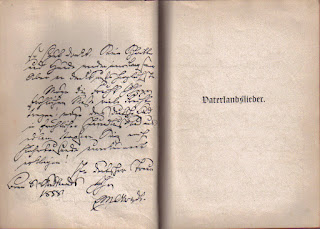Every picture tells a story, season 3, picture 17
last update: 11.4.2024
Let's go back to the Krefeld Clan - the 13 children of silk weaver Wilhelm Düselmann and Elisabetha de la Strada who married in 1826 and agreed to bring up the boys protestants (like their father) and the girls catholics (like their mother).
Of the 13 children, we have seen child number 7 Karl the foreman (and father of enterprising Julius) and child number 10 August the fireman (and father of adventurous Walter).
I don't think I have any photos of any of the other 11, so if any of the hundreds of descendants out there would like to share some I'd be very grateful.
What I do have though is the husband and three children of child number 9, Henriette Düselmann, who was born in 1843.
In 1863 she married confectioner (Conditor und Zuckerbäcker) Joseph Hermann Bender (born 1840). He has a database entry here, where funnily enough only the sons are listed, whereas all the info on descendants I have concerns two of the three daughters of the couple. Anyhow, here's the confectioner in around 1895 with his son Nicolas, left, both daughters, and an employee called Nik (or possibly Josef Hermann's brother Nicolaus - I have contradictory infos on this?!):
Firstborn child Gertrud married Wilhelm Heinrich Habrich; Josefine married Wilhelm Max Holler (brother of the painter Alfred Holler), shown here:
Each had four children, so the complete set of eight born between 1902 and 1912 is here (maybe around 1915 judging by the size of the youngest standing on the bench?):
And this is a wider family gathering for Pentecost (Whitsun) 1926
Here we have the confectioner's daughters Gertrud (2nd from left) and Josefine (3rd). Far left is Gertrud's husband, Wilhelm Heinrich Habrich. Josefine's husband, Wilhelm Max Holler, is the 6th from left. On either side of him two Holler children, and on the right of the picture four Habrich children lined up.
Open questions: The woman fourth from left is unidentified according to my source, but given the symmetry of the picture with three sisters ligned up on the right, I am tempted to speculate it could be the third daughter of the confectioner, Klara Bender, see below? Trouble is we don't know much about Klara. The 8th person is named as Adolf Peters. We don't know anything about him but note that the grandmother of Gertrud and Josefine, Elisabetha de la Strada, had a brother who married a Gertraud Peters, so there could be a remote family link.
In the ancient Krefeld Clan blog entry I had two other children of Henriette and the confectioner (in addition to Gertrud and Josephine):
9.3. Nicolas Joseph Bender * 22.4.1864 Krefeld
9.4. Klara Bender * Krefeld
Digging up some old correspondence I find that Nicolas moved to Berlin and Klara was severely injured in an accident with a horse carriage.
The database entry reveals a second son I didn't know of:
Heinrich Bender * 30.10.1871
But it shows no marriage or offspring for either of the sons.
So I had the sibling order all wrong,it should be:
- Nicolas Joseph Bender * 1864
- Gertrud * 1870
- Heinrich Bender * 1871
- Josefine * 1881
And we still don't know where Klara fits in - the biggest gap to accommodate her would be before Josefine.
Another mystery that's possibly related: I have a 19th century student song book signed Hermann Bender, inherited from Esther the travelling saleswoman who came from the Krefeld clan, so it could be an heirloom linked to the old confectioner, but then again she also bought antiquarian books, so it could be a coincidence. Will have to do a separate entry on that at some point (UPDATE: done now).
Should anybody have any answers to some of the many questions I am raising in this series, please leave a comment here (I'll need to vet it, so it may take a few days before it goes public) or contact me at michaelgrr [at] yahoo [dot] co [dot] uk
Navigation tools:
Season 3 so far:
- family holiday
- play time
- fashion show
- bakery to butcher's shop
- the Hamborn brotherhood
- all grown up
- sisters in the snow
- the last holiday
- village life
- family reshuffle
- push bike
- mystery trio
- confirmands at Hamborn
- streets of Hamborn
- more grandchildren
- a Russian winter
- a confectioner's business
The Mastodon thread for season 3 is here.
You can find Season 2 entries in this thread on Mastodon (complete now!) or via the list at the bottom of the last entry of the season (and also at the bottom of the first entry of this season).
The twitter thread for season 1 is still here. Alternatively, visit the last instalment and find the numbered list of entries at the bottom.




































